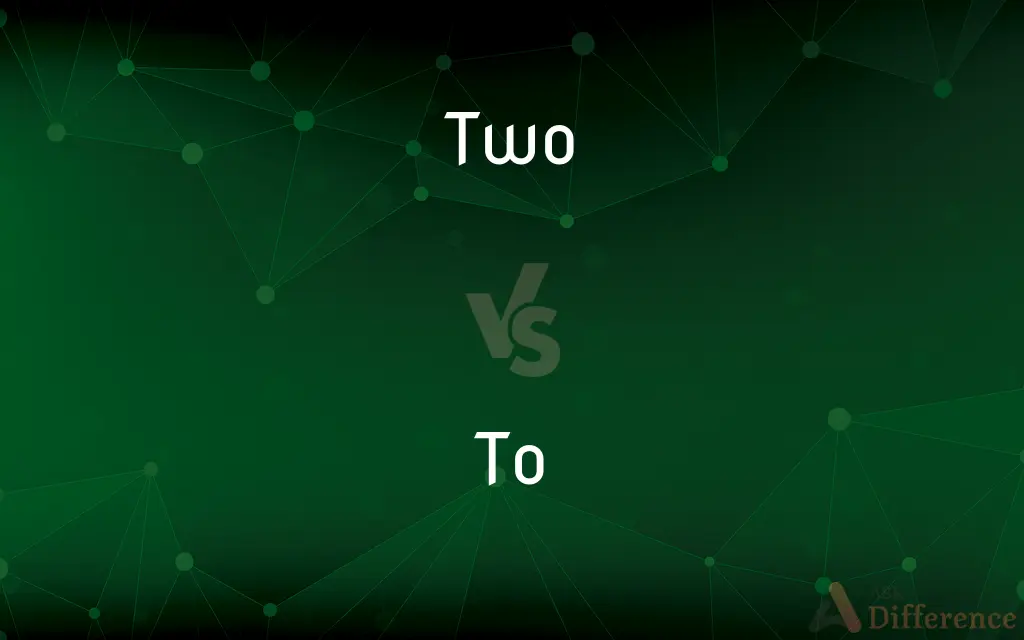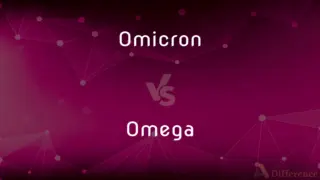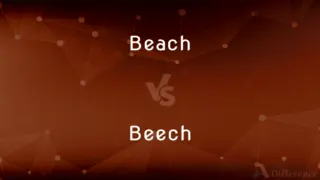Two vs. To — What's the Difference?
By Urooj Arif & Fiza Rafique — Updated on March 9, 2024
"Two" refers to the number after one, highlighting quantity, while "to" is a preposition or part of an infinitive, indicating direction or purpose.

Difference Between Two and To
Table of Contents
ADVERTISEMENT
Key Differences
"Two" is a cardinal number representing the quantity that is one plus one. It is used in counting and quantifying objects, emphasizing the exact number of items in a group. For example, when you say, "I have two apples," you are specifying that you possess exactly two units of apples. On the other hand, "to" serves primarily as a preposition or a part of an infinitive verb. As a preposition, it indicates direction, purpose, or destination, such as in the sentence, "We are going to the park."
While "two" is always numerical and relates to counting, "to" can introduce a goal or intention. For instance, "I am walking to the store" uses "to" to show the purpose of walking, which is reaching the store.
"Two" is used in mathematics and various contexts requiring precision in quantity, such as measurements or rankings, like "She finished in two hours" or "He was second in a race of two." In contrast, "to" can also indicate a relationship between things or activities, as in "This gift is from me to you," showcasing a movement or transfer from one person to another.
Comparison Chart
Part of Speech
Noun (number)
Preposition or infinitive marker
Usage
Quantification
Direction, purpose, or infinitive
ADVERTISEMENT
Context
Counting, mathematics
Movement, intention, action
Examples
"I need two pencils."
"I'm going to the market."
Distinctive Feature
Specifies quantity
Indicates direction or purpose
Compare with Definitions
Two
Represents the number following one.
I bought two tickets for the concert.
To
Indicates direction or destination.
We walked to the park.
Two
Integral in equations and counting.
Two plus two equals four.
To
Used with a verb to form an infinitive.
She loves to sing.
Two
Indicates quantity in measurements.
He drank two liters of water.
To
Suggests intention or objective.
This letter is addressed to John.
Two
Can denote position in order.
She finished the race in two hours.
To
Indicates a result or consequence.
The noise woke me up to reality.
Two
Used to specify an exact count.
She has two cats at home.
To
Used in expressions of comparison.
He prefers coffee to tea.
Two
The cardinal number equal to the sum of 1 + 1.
To
Expressing motion in the direction of (a particular location)
We're going to a party
Walking down to the shops
My first visit to Africa
Two
The second in a set or sequence.
To
Approaching or reaching (a particular condition)
Christopher's expression changed from amazement to joy
She was close to tears
Two
Something having two parts, units, or members, especially a playing card, the face of a die, or a domino with two pips.
To
Identifying the person or thing affected by or receiving something
You were terribly unkind to her
They donated £400 to the hospice
I am deeply grateful to my parents
Two
A two-dollar bill.
To
Identifying a particular relationship between one person and another
He's economic adviser to the president
He is married to his cousin Emma
Two
A numerical value equal to 2; this many dots (••).
To
Indicating that two things are attached or linked
They are inextricably linked to this island
He had left his dog tied to a drainpipe
Two
Describing a set or group with two elements.
To
Concerning or likely to concern (something)
A threat to world peace
A reference to Psalm 22:18
Two
The digit/figure 2.
The number 2202 contains three twos.
To
Used to introduce the second element in a comparison
The club's nothing to what it once was
Two
A two-dollar bill.
To
Placed before a debit entry in accounting.
Two
A child aged two.
This toy is suitable for the twos and threes.
To
So as to be closed or nearly closed
He pulled the door to behind him
Two
A playing card featuring two pips.
To
In a direction toward so as to reach
Went to the city.
Two
Two o'clock, either a.m. or p.m.
To
Towards
Turned to me.
Two
One and one; twice one.
To
Reaching as far as
The ocean water was clear all the way to the bottom.
Two
The sum of one and one; the number next greater than one, and next less than three; two units or objects.
To
To the extent or degree of
Loved him to distraction.
Two
A symbol representing two units, as 2, II., or ii.
To
With the resultant condition of
Nursed her back to health.
Two
The cardinal number that is the sum of one and one or a numeral representing this number
To
Toward a given state
Helping minority women to economic equality.
Two
Being one more than one;
He received two messages
To
In contact with; against
Their faces pressed to the windows.
To
In front of
Stood face to face.
To
Used to indicate appropriation or possession
Looked for the top to the jar.
To
Concerning; regarding
Waiting for an answer to my letter.
To
In a particular relationship with
The brook runs parallel to the road.
To
As an accompaniment or a complement of
Danced to the tune.
To
Composing; constituting
Two cups to a pint.
To
In accord with
Job responsibilities suited to her abilities.
To
As compared with
A book superior to his others.
To
Before
The time is ten to five.
To
Up till; until
Worked from nine to five.
To
For the purpose of
Went out to lunch.
To
In honor of
A toast to the queen.
To
Used before a verb to indicate the infinitive
I'd like to go.
To
Used alone when the infinitive is understood
Go if you want to.
To
Used to indicate the relationship of a verb with its complement
Refer to a dictionary.
Refer me to a dictionary.
To
Used with a reflexive pronoun to indicate exclusivity or separateness
Had the plane to ourselves.
To
In one direction; toward a person or thing
Owls with feathers wrong end to.
To
Into a shut or closed position
Pushed the door to.
To
Into a state of consciousness
The patient came to.
To
Into a state of action or attentiveness
Sat down for lunch and fell to.
To
(Nautical) Into the wind.
To
Indicating destination: In the direction of, so as to arrive at.
We are walking to the shop.
To
Used to indicate the target or recipient of an action.
I gave the book to him.
I spoke to him earlier.
He devoted himself to education.
They drank to his health.
To
Used to indicate result of action.
His face was beaten to a pulp.
To
Used to indicate a resulting feeling or emotion.
To everyone's great relief, the tuneless carol singers finally ceased their warbling.
To
Used after an adjective to indicate its application.
Similar to ..., relevant to ..., pertinent to ..., I was nice to him, he was cruel to her, I am used to walking.
To
Denotes the end of a range.
It takes 2 to 4 weeks to process typical applications.
To
As a.
With God to friend (with God as a friend);
With The Devil to fiend (with the Devil as a foe);
Lambs slaughtered to lake (lambs slaughtered as a sacrifice);
Took her to wife (took her as a wife);
Was sold to slave (was sold as a slave).
To
Used to indicate a ratio or comparison; compared to, as against.
One to one = 1:1
Ten to one = 10:1.
I have ten dollars to your four.
To
(arithmetic) Used to indicate that the preceding term is to be raised to the power of the following value; indicates exponentiation.
Three squared or three to the second power is nine.
Three to the power of two is nine.
Three to the second is nine.
To
(time) Preceding the next hour.
What's the time? – It's quarter to four in the afternoon (or 3:45 pm).
To
(informal) Often used without the hour
It’s quarter to (3:45, or 4:45, or whatever time ending in 45 would make the most sense)
To
Used to describe what something consists of or contains.
Anyone could do this job; there's nothing to it.
There's a lot of sense to what he says.
The name has a nice ring to it.
To
According to
Our holiday did not go to plan.
To
At.
Stay where you're to and I'll come find you, b'y.
Where are you to?
To
(regionalism) Toward a closed, touching or engaging position.
Please push the door to.
To
(nautical) Into the wind.
To
The preposition to primarily indicates approach and arrival, motion made in the direction of a place or thing and attaining it, access; and also, motion or tendency without arrival; movement toward; - opposed to from.
Stay with us, go not to Wittenberg.
So to the sylvan lodgeThey came, that like Pomona's arbor smiled.
I'll to him again, . . . He'll tell me all his purpose.She stretched her arms to heaven.
To
Hence, it indicates motion, course, or tendency toward a time, a state or condition, an aim, or anything capable of being regarded as a limit to a tendency, movement, or action; as, he is going to a trade; he is rising to wealth and honor.
To
As sign of the infinitive, to had originally the use of last defined, governing the infinitive as a verbal noun, and connecting it as indirect object with a preceding verb or adjective; thus, ready to go, i.e., ready unto going; good to eat, i.e., good for eating; I do my utmost to lead my life pleasantly. But it has come to be the almost constant prefix to the infinitive, even in situations where it has no prepositional meaning, as where the infinitive is direct object or subject; thus, I love to learn, i.e., I love learning; to die for one's country is noble, i.e., the dying for one's country. Where the infinitive denotes the design or purpose, good usage formerly allowed the prefixing of for to the to; as, what went ye out for see? (Matt. xi. 8).
Then longen folk to go on pilgrimages,And palmers for to seeken strange stranders.
To
In many phrases, and in connection with many other words, to has a pregnant meaning, or is used elliptically.
We ready are to try our fortunesTo the last man.
Few of the Esquimaux can count to ten.
To
Effect; end; consequence; as, the prince was flattered to his ruin; he engaged in a war to his cost; violent factions exist to the prejudice of the state.
Now we see through a glass, darkly; but then face to face.
To
Accord; adaptation; as, an occupation to his taste; she has a husband to her mind.
He to God's image, she to his was made.
To
Comparison; as, three is to nine as nine is to twenty-seven; it is ten to one that you will offend him.
All that they did was piety to this.
To
Addition; union; accumulation.
Wisdom he has, and to his wisdom, courage.
To
Accompaniment; as, she sang to his guitar; they danced to the music of a piano.
Anon they moveIn perfect phalanx to the Dorian moodOf flutes and soft recorders.
To
Character; condition of being; purpose subserved or office filled.
Made his masters and others . . . to consider him to a little wonder.
To-morrow, and to-morrow, and to-morrow;Creeps in this petty pace from day to day.
There was great showing both to and fro.
Common Curiosities
Are "two" and "to" interchangeable?
No, they serve different purposes; "two" is a number, while "to" is a preposition or infinitive marker.
Can "to" be used with verbs?
Yes, "to" is often used as part of an infinitive verb, such as "to run" or "to play."
How is "to" used in a sentence?
"To" can indicate direction, purpose, or be part of an infinitive verb.
Can "two" be used in mathematical expressions?
Yes, "two" is commonly used in math to represent the number 2.
Can "two" indicate a sequence?
Yes, "two" can denote a position in a sequence, often followed by "in a series" or similar phrases.
Does "to" have synonyms?
As a preposition, synonyms might include "toward" or "into," depending on the context.
Is "to" used in idiomatic expressions?
Yes, "to" appears in many idioms, like "to add insult to injury."
Is "two" only used for counting?
Yes, "two" is a cardinal number used specifically for counting and indicating quantity.
Does the pronunciation of "two" and "to" differ?
No, they are homophones and sound the same, but their meanings and uses are different.
Is "to" always followed by a verb?
As an infinitive marker, yes, but as a preposition, it can be followed by a noun or pronoun.
Can "two" be used in non-mathematical contexts?
Absolutely, "two" is used in everyday language to indicate quantity in various situations.
Is "to" used in formal writing?
Yes, "to" is widely used in both formal and informal contexts.
Can "two" be used metaphorically?
It's less common, but "two" can be used metaphorically, like in "two of a kind."
Can "two" denote a pair or duo?
Yes, "two" can refer to a pair of items or individuals, implying a duo or couple.
Share Your Discovery

Previous Comparison
Omicron vs. Omega
Next Comparison
Beach vs. BeechAuthor Spotlight
Written by
Urooj ArifUrooj is a skilled content writer at Ask Difference, known for her exceptional ability to simplify complex topics into engaging and informative content. With a passion for research and a flair for clear, concise writing, she consistently delivers articles that resonate with our diverse audience.
Co-written by
Fiza RafiqueFiza Rafique is a skilled content writer at AskDifference.com, where she meticulously refines and enhances written pieces. Drawing from her vast editorial expertise, Fiza ensures clarity, accuracy, and precision in every article. Passionate about language, she continually seeks to elevate the quality of content for readers worldwide.














































